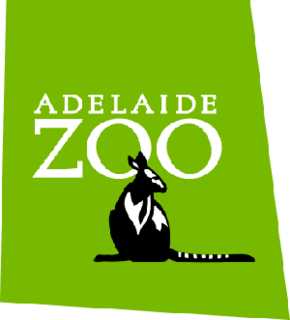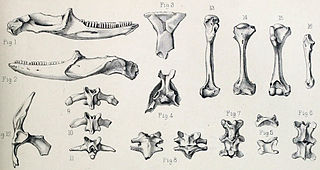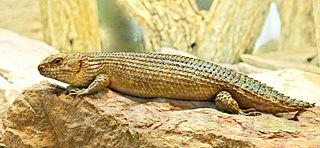
Egernia is a genus of skinks that occurs in Australia. These skinks are ecologically diverse omnivores that inhabit a wide range of habitats. However, in the loose delimitation the genus is not monophyletic but an evolutionary grade, as has long been suspected due to its lack of characteristic apomorphies.

Taronga Zoo is a zoo located in Sydney, New South Wales, Australia, in the suburb of Mosman, on the shores of Sydney Harbour. The opening hours are between 9:30 a.m. to 5 p.m.

Perth Zoo is a 41-acre (17 ha) zoological park in South Perth, Western Australia. The zoo first opened in 1898 and by 2011 housed 1258 animals of 164 species and an extensive botanical collection. It is a full institutional member of the Zoo and Aquarium Association (ZAA) and the World Association of Zoos and Aquariums (WAZA).

Blue-tongued skinks comprise the Australasian genus Tiliqua, which contains some of the largest members of the skink family (Scincidae). They are commonly called blue-tongued lizards or simply blue-tongues or blueys in Australia. As suggested by these common names, a prominent characteristic of the genus is a large blue tongue that can be bared as bluff-warning to potential enemies. The type of predator/threat that is near will determine the intensity of colour present in the tongue. In addition, their blue tongue will produce a response in the prey which will in turn diminish the attack. The tongue can also deform itself and produce a thick mucus in order to catch prey. They are relatively shy in comparison with other lizards, and also significantly slower due to their short legs.

The blotched blue-tongued lizard, also known as the southern blue-tongued lizard or blotched blue-tongued skink is a blue-tongued skink endemic to south-eastern Australia.

Adelaide Zoo is Australia's second oldest zoo, and it is operated on a non-profit basis. It is located in the parklands just north of the city centre of Adelaide, South Australia. It is administered by the Royal Zoological Society of South Australia Incorporated, which is a full institutional member of the Zoo and Aquarium Association (ZAA) and the World Association of Zoos and Aquariums (WAZA), and which also administers the Monarto Safari Park near Murray Bridge.

Threatened fauna of Australia are those species and subspecies of birds, fish, frogs, insects, mammals, molluscs, crustaceans and reptiles to be found in Australia that are in danger of becoming extinct. This list is the list proclaimed under the Australian federal Environment Protection and Biodiversity Conservation Act 1999. The classifications are based on those used by the World Conservation Union (IUCN), however IUCN and Australian rankings do differ. Each state and territory has its own legislation relating to environmental protection.

A burrow is a hole or tunnel excavated into the ground by an animal to construct a space suitable for habitation or temporary refuge, or as a byproduct of locomotion. Burrows provide a form of shelter against predation and exposure to the elements and can be found in nearly every biome and among various biological interactions. Many different animal species are known to form burrows. These species range from small invertebrates, such as the Corophium arenarium, to very large vertebrate species such as the polar bear. Burrows can be constructed into a wide variety of substrates and can range in complexity from a simple tube a few centimeters long to a complex network of interconnecting tunnels and chambers hundreds or thousands of meters in total length; an example of the latter level of complexity, a well-developed burrow, would be a rabbit warren.

Monarto Safari Park, formerly known as Monarto Zoological Park and Monarto Zoo, is a 1,500-hectare (3,700-acre) open-range zoo located in South Australia administered by the Royal Zoological Society of South Australia. It is located at Monarto, approximately 70 kilometres (43 mi) from Adelaide's centre.

The Tiliqua scincoides scincoides, or eastern blue-tongued lizard, is native to Australia. It is unique due to its blue tongue, which can be used to warn off predators. In addition to flashing its blue tongue, the skink hisses and puffs up its chest to assert dominance and appear bigger when in the presence of its predators such as large snakes and birds. The eastern blue tongue is ovoviviparous and precocial, meaning that its young are more developed and advanced at their time of birth. The Tiliqua scincoides scincoides is not poisonous to humans and can be found in suburban and urban areas, specifically in house gardens.

The western blue-tongued lizard, also known as the western blue-tongued skink, is a large skink native to Australia. It is one of six species of blue-tongued skinks found in Australia, though further species are found in New Guinea and Indonesia.

The northern blue-tongued skink is the largest and heaviest of the blue-tongued lizards. They are native to Australia and found almost exclusively in the Northern Region. They generally live around 20 years and are commonly kept as pets.

Leiolopisma mauritiana is a large, extinct species of skink. It was found only in Mauritius, but became extinct around 1600 probably due to introduced predators.
Aethesia is an extinct skink possibly related to the extant genus Tiliqua, blue-tongued skinks. It is known from the Wellington Caves of New South Wales in Australia. The holotype is the anterior portion of the left mandible, from the symphysis to the splenial bone and containing portions of the coronoid. Teeth number 9 to 15 are intact, with the eighth being a partial tooth and none of the other remaining past the mandible. The teeth slightly enlarge from anterior to posterior.

Tiliqua scincoides is a species of skink. It is native to Australia as well as to the Tanimbar and Babar Islands in the Maluku Province of Indonesia.

The Centralian blue-tongued skink or Centralian blue-tongue is a species of skink, occurring predominantly in the far north-west corner of New South Wales, Australia. It is one of six species belonging to the genus Tiliqua; the blue-tongued skinks and the shinglebacks.

Egernia stokesii is a gregarious species of lizard of the Scincidae family. This diurnal species is endemic to Australia, and is also known as the Gidgee skink, spiny-tailed skink, Stokes's skink and Stokes's egernia. The species forms stable, long-term social aggregations, much like the social groups seen in mammalian and avian species. This characteristic is rarely found in the Squamata order, but is widespread within the Australian subfamily of Egerniinae skinks. Populations of E. stokesii are widely distributed, but fragmented, and occur in semi-arid environments. There are three recognised subspecies. The conservation status for the species is listed as least concern, however, one subspecies is listed as endangered.

The alpine she-oak slender bluetongue or alpine she-oak skink is a species of lizard in the family Scincidae. The species is endemic to the Australian Alps.


















